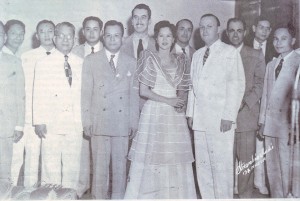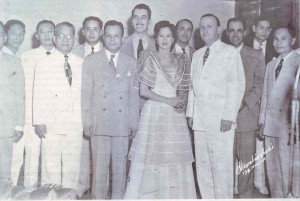By PABLO TARIMAN

THE University of Santo Tomas (UST) Conservatory of Music has many reasons to celebrate its 65th year.
First, it is the only music school which has mounted two full-length operas (Tchaikovsky’s “Eugene Onegin” and Strauss’ “Die Fledermaus”) in a span of two years, showcasing the best musical talents of the conservatory.
The graduates and teachers of UST also happen to be one of the most sought after in Manila’s music scene.
Soprano Rachelle Gerodias, who sits in the music faculty, has just wrapped up several well-acclaimed engagements, including the Vienna and Singapore productions of Puccini’s “Turandot” (as Liu). Her co-teacher, tenor Lemuel de la Cruz, is in the same recent Singapore production and will perform the role of Gaston in this year’s Singaporean production of “La Traviata.”
Other products of the UST conservatory include Rodel Colmenar, who conducted Cecile Licad in the much-acclaimed performance of Rachmaninoff’s “Piano Concerto No. 3,” and Mary Anne Espina, who has accompanied a number of international soloists from violinist Alexandru Tomescu to tenor Otoniel Gonzaga.
To top it all, three of its former teachers and directors (Col. Antonino Buenaventura, Antonio Molina and Ernani Cuenco) are National Artists for Music.
It is also one of the few music schools with an orchestra (The UST Symphony), and award-winning choirs (The UST Singers and Coro Tomasino).
“The UST Conservatory had been at the forefront of musical performances in the country,” UST Conservatory head Raul Sunico said. “It has also supplied many musicians in the various orchestras, classical and popular bands both here and abroad, and has lent the services of some faculty members to other music schools.”
Dr. Sunico, who happens to be one of the country’s finest pianists, succeeded Erlinda Fule as dean of the conservatory in February 2002. Other equally distinguished music personalities helped make the music school what it is today — one of the best in the country and in Asia.
The music school was founded in 1946, formally opening with an inaugural concert. Fr. Rector Eugenio Jordan said the occasion was the first time in the long educational history of the tricentennial institution that a school of music was established.
Initially, the music school was part of the College of Architecture and Fine Arts (CAFA). Its first director was Manuel Cuerva, who used to be the director of the UST ROTC Band.
In the book “The University of Santo Tomas in the 20th Century,” writer Josefina Lim Pe wrote: “Generally regarded as the founder of the Conservatory is Fr. Gregorio Garcia, O.P. whose initiative and encouragement inspired the opening of the Conservatory.” However, it was subsequent music head and Barcelona-educated pianist Julio Esteban Anguita who enriched the school and gave it solid direction.
Soprano Gloria Coronel–who studied voice in the late 1950s and is at present in the music faculty–shared her fond memories of the early years of the UST Conservatory of Music. “The music school that I remember during my time was just a Quonset hut with modest studios and an auditorium,” she recalled.
Among the school’s equally distinguished mentors were pianist and conductor Bernardino Custodio, cellist Antonio Molina, violinist Ramon Corpus and later, piano teacher Julie Ann Hallazgo, and the so-called “great damsels of (piano) pedagogy” Stella Goldenberg Brimo, Aida Sanz Gonzalez, Milagros de Ocampo and Rosario Picazo (the first teacher of Cecile Licad).
The first wave of divas who taught in the school included Mercedes Matias-Santiago (the country’s first Lucia di Lamermoor), Lourdes Corrales de Razon and Salvacion Oppus-Iniguez, among others. The later batch included Irma P.E. Potenciano, Gloria Dizon-Coronel and Erlinda Dacanay-Azcuna.
Other notable teachers from the conservatory were violinist-conductor Sergio Esmilla Jr., sopranos Conching Rosal, Sylvia la Torre, Leticia Liboon, Juanito Javier-Torres and Fara Lizardo.
“The UST Conservatory strives to be globally competitive, especially in the field of performance and new program offerings such as jazz studies, music technology, and musical theater,” Sunico said.
According to Sunico, the career choices of the school’s music graduates are now virtually limitless. “The Conservatory trains students in the classical way, but this training can be adapted later for those who want to venture into other musical genres such as pop, rock, and jazz,” Sunico said. “As a result, the quality of our graduates is generally high.”
That is why their music graduates do not find it difficult to find employment, he added.
One artist who can represent the best of the UST Conservatory of Music is pianist Reynaldo Reyes–a prizewinner of the Rio de Janeiro International Piano Competition, the Busoni Competition in Italy and the Marguerite Long Competition in Paris
“There is no doubt in my mind that UST was one of the best music schools in the late ‘40s to the early ‘50s,” Reyes said. “Its biggest come-on was Prof. Julio Esteban Anguita, who recruited the best teachers at the time and suddenly, the UST conservatory was the most exciting place to be. Now, it is also the most progressive.”
Today, the UST Conservatory has the highest enrollment (650) among the music schools in the country.
